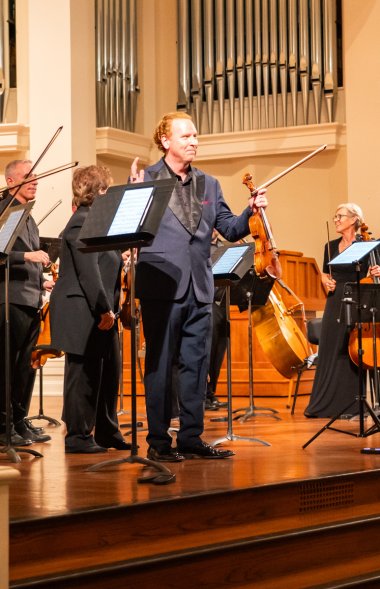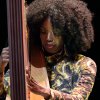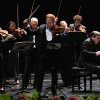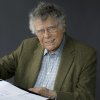
In a week of Halloween-themed entertainment, New Century Chamber Orchestra chose an unseasonal route for their season opener. The string orchestra played a set of nature-themed works that were so sweet and un-spooky they would have had Tim Burton running for the hills.
With Music Director Daniel Hope as concertmaster and a powerful soloist in Vivaldi’s The Four Seasons, Thursday’s concert at the First Congregational Church of Berkeley showcased the marvelous unity of purpose and the vibrant sound that the musicians of New Century Chamber Orchestra command.
The concert’s big surprise was Bulgarian British composer Dobrinka Tabakova’s Dawn, written in 2007 for Kremerata Baltica celebrating violinist Gidon Kremer’s 60th birthday. It’s a gorgeous, 14-minute Romantic tone poem that’s conventionally tonal and filled with melodic light. The composer is so resourceful in pulling different colors and moods from the strings that it’s no wonder this work, a part of her Sun Trilogy, has been taken into the string orchestra repertory. As Hope said, this is mesmerizing music.

Tabakova charts the expected path from the first glow on the horizon in soft, whispering, drawn-out chords to full daylight. She uses a solo violin and cello to initiate the movement which grows to melodies shared with the full string section. Hope and principal cello Evan Kahn played off each other brilliantly, animated by Hope’s expressive body language — he intentionally steps toward the player he’s “speaking” with. The orchestra triumphed in this easy-to-love work.
Antonin Dvorak’s sunny Serenade for Strings (1875) increased the good feelings that Dawn inspired. The serenade may not directly address the rural Bohemia of Dvorak’s youth, but there are folk-like references, like the minor key waltz in the second movement that dovetails with a complementary theme in modal harmony, or the dancelike finale with its syncopated accents. Suffused with an unfailingly genial melody, this piece is also wonderfully constructed. The tunes trade off between sections — ingenious imitative counterpoint — and inventive harmonic turns that contribute greatly to the musical flow.
The orchestra’s warm sound is perfect for Dvorak’s work. The section balances, so important here, were perfect. I doubt anyone could play this work any better. If you didn’t hear it, pray this orchestra records it.

You might imagine that a historical performance group would have more to say about Vivaldi’s famous concertos, and the Venetian Baroque style, than the modern-instrument NCCO. However, buttressed by Jon Mendle on theorbo/Baroque guitar and Derek Tam on harpsichord, the orchestra gave a fully realized, delightful reading of these familiar works.
Vivaldi’s daring programmatic touches played directly into Hope’s strengths, and he accentuated those aspects with nuance and a sense of drama. The orchestra made the most of the work’s contrasting tempos and sound effects. More than a few of Hope’s solos showed off a fiery virtuosity that somehow only enhanced the collegiality he shares with NCCO’s players.
The concert set was the perfect way to start off a season dedicated to the orchestra’s major donor, Gordon Getty, and it certainly put a spring in my step — ghosts and ghouls begone.




